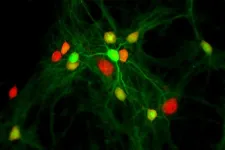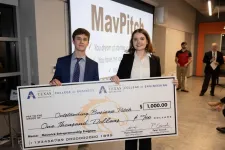(Press-News.org) A new USC-led study on rats that feasted on a high-fat, sugary diet raises the possibility that a junk food-filled diet in teens may disrupt their brains’ memory ability for a long time.
“What we see not just in this paper, but in some of our other recent work, is that if these rats grew up on this junk food diet, then they have these memory impairments that don’t go away,” said Scott Kanoski, a professor of biological sciences at the USC Dornsife College of Letters, Arts and Sciences. “If you just simply put them on a healthy diet, these effects unfortunately last well into adulthood.”
The study appears in the May issue of the journal Brain, Behavior, and Immunity.
In developing the study, Kanoski and lead author and postdoctoral research fellow Anna Hayes considered that prior research has shown a link between poor diet and Alzheimer’s disease. People who suffer from Alzheimer’s disease tend to have lower levels of a neurotransmitter called acetylcholine in the brain that is essential for memory and functions such as learning, attention, arousal and involuntary muscle movement.
The team wondered what this could mean for younger people who may be on a similar fat-filled, sugary Western diet, particularly during adolescence when their brain is undergoing significant development. By tracking the impact of the diet on the rats’ levels of acetylcholine, and running the rats through some memory testing, they could learn more about the important relationship between diet and memory.
The researchers tracked the acetylcholine levels of a group of rats on a fatty, sugary diet and in a control group of rats by analyzing their brain responses to certain tasks designed to test their memory. The team examined the rats’ brains post-mortem for signs of disrupted acetylcholine levels.
The memory test involved letting the rats explore new objects in different locations. Days later, the researchers reintroduced the rats to the scene that was nearly identical except for the addition of one new object. Rats on the junk food diet showed signs they could not remember which object they had previously seen, and where, while those in the control group showed familiarity.
“Acetylcholine signaling is a mechanism to help them encode and remember those events, analogous to ‘episodic memory’ in humans that allows us to remember events from our past,” lead author Hayes explained. “That signal appears to not be happening in the animals that grew up eating the fatty, sugary diet.”
Kanoski emphasized that adolescence is a very sensitive period for the brain when important changes are occurring in development. “I don’t know how to say this without sounding like Cassandra and doom and gloom,” he said, “but unfortunately, some things that may be more easily reversible during adulthood are less reversible when they are occurring during childhood.”
There is at least some hope for intervention. Kanoski said that in another round of the study, the research team examined whether the memory damage in rats raised on the junk food diet could be reversed with medication that induces the release of acetylcholine. They used two drugs, PNU-282987 and carbachol, and found that with those treatments given directly to the hippocampus, a brain region that controls memory and is disrupted in Alzheimer’s disease, the rats’ memory ability was restored.
But without that special medical intervention, Kanoski said more research is needed to know how memory problems from a junk food diet during adolescence can be reversed.
In addition to Kanoski and Hayes, the team included other USC Dornsife researchers Logan Tierno Lauer, Alicia E. Kao, Molly E. Klug, Linda Tsan, Jessica J. Rea, Keshav S. Subramanian, Cindy Gu, Arun Ahuja, Kristen N. Donohue and Léa Décarie-Spain; Natalie Tanios of Keck School of Medicine of USC; as well as Anthony A. Fodor, Shan Sun of University of North Carolina-Charlotte.
The work was supported by the following: National Institute of Diabetes and Digestive and Kidney Diseases grant DK123423 (SEK, AF), National Institute of Diabetes and Digestive and Kidney Diseases grant DK104897 (SEK), Postdoctoral Ruth L. Kirschstein National Research Service Award from the National Institute on Aging F32AG077932 (AMRH), National Science Foundation Graduate Research Fellowships (separate awards to LT and KSS), Quebec Research Funds postdoctoral fellowship 315201 (LDS) and the Alzheimer’s Association Research Fellowship to Promote Diversity AARFD-22-972811 (LDS).
END
Take it from the rats: A junk food diet can cause long-term damage to adolescent brains
Rats that were fed a diet chock-full of fat and sugar in their adolescence suffered memory impairment, USC researchers found.
2024-04-16
ELSE PRESS RELEASES FROM THIS DATE:
Fralin Biomedical Research Institute team unpacking genetic mysteries of childhood epilepsies
2024-04-15
Epilepsy is a brain disorder that causes recurring seizures.
It is one of the most common neurological diseases, and it affects approximately 50 million people worldwide, according to the World Health Organization. In 2023, nearly 450,000 children in the United States were diagnosed with the disease.
Virginia Tech researchers at the Fralin Biomedical Research Institute at VTC are exploring how gene variants identified in children with severe epilepsy can have an impact on neurons, leading to abnormal ...
UNC-Chapel Hill researchers discover new clues to how tardigrades can survive intense radiation
2024-04-15
University of North Carolina at Chapel Hill researchers have discovered that tardigrades – microscopic animals famed for surviving harsh extremes – have an unusual response to radiation.
Led by UNC-Chapel Hill researcher Bob Goldstein’s lab, the new research paper published on April 12 in Current Biology reveals new details on tardigrades’ responses to radiation. Radiation has long been known to damage DNA, and in humans, DNA damage from excessive radiation exposure can lead to diseases. But the tardigrades have an unexpected way to correct the damage.
“What we saw surprised us,” said Goldstein. “The ...
UT Arlington prioritizes entrepreneurship efforts
2024-04-15
Universities are engines for economic growth that today are supporting technology development, innovation and economic advancement as never before.
With the launch of its Center for Entrepreneurship and Technology Development (CETD), The University of Texas at Arlington is beginning a new era of support for student and faculty entrepreneurship. The center, whose mandate also includes supporting the region’s vibrant innovation economy, will expand UTA’s engagement with public and private partners everywhere.
“CETD fosters a vibrant and supportive atmosphere ...
Ochsner Health receives 2024 Top Workplaces Culture Excellence Awards
2024-04-15
NEW ORLEANS, La – Ochsner Health is the recipient of the 2024 Top Workplaces Culture Excellence awards in four distinguished categories: Innovation, Work-Life Flexibility, Leadership and Purposes & Values. These accolades are administered by Energage, a purpose-driven organization that develops solutions to build and brand Top Workplaces.
The Top Workplaces program has a 17-year history of surveying and celebrating people-first organizations nationally and across 60 regional markets. Top Workplaces awards are based on feedback from a research-backed employee engagement survey.
“It is an honor to receive ...
Are these newly found rare cells a missing link in color perception?
2024-04-15
Scientists have long wondered how the eye’s three cone photoreceptor types work together to allow humans to perceive color. In a new study in the Journal of Neuroscience, researchers at the University of Rochester used adaptive optics to identify rare retinal ganglion cells (RGCs) that could help fill in the gaps in existing theories of color perception.
The retina has three types of cones to detect color that are sensitive to either short, medium, or long wavelengths of light. Retinal ganglion cells transmit input from these cones to the central nervous system.
In the 1980s, David Williams, the William G. Allyn Professor of Medical Optics, ...
Annals supplement highlights important new evidence readers ‘may have missed’ in 2023
2024-04-15
Embargoed for release until 5:00 p.m. ET on Monday 15 April 2024
Annals of Internal Medicine Tip Sheet
@Annalsofim
Below please find summaries of new articles that will be published in the next issue of Annals of Internal Medicine. The summaries are not intended to substitute for the full articles as a source of information. This information is under strict embargo and by taking it into possession, media representatives are committing to the terms of the embargo not only on their own behalf, but also on behalf ...
NIH awards $2.3 million grant to University of Oklahoma for gene therapy research
2024-04-15
NORMAN, OKLA. – University of Oklahoma engineering researcher Sangpil Yoon, Ph.D., has been awarded a $2.3 million grant from the U.S. Department of Health and Human Services, National Institutes of Health, for his project titled “Development of protein-based nanostructures activated by ultrasound.”
The five-year grant is part of the NIH’s Research Project Grant (R01) program, which supports cutting-edge health-related research and development initiatives. Yoon’s funding, totaling $363,919 for ...
Hidden threat: Global underground infrastructure vulnerable to sea-level rise
2024-04-15
As sea levels rise, coastal groundwater is lifted closer to the ground surface while also becoming saltier and more corrosive. A recent study by earth scientists at the University of Hawai‘i (UH) at Mānoa compiled research from experts worldwide showing that in cities where there are complex networks of buried and partially buried infrastructure, interaction with this shallower and saltier groundwater exacerbates corrosion and failure of critical systems such as sewer lines, roadways, and building foundations.
“While it has been recognized that shallowing groundwater will eventually result in chronic flooding as it surfaces, ...
Study reveals AI enhances physician-patient communication
2024-04-15
As one of the first health systems in the country to pilot the use of generative artificial intelligence (GenAI) to draft replies to patient messages inside the Epic Systems electronic health record, UC San Diego Health is a pioneer in shaping the future of digital health.
The results of a new University of California San Diego School of Medicine study indicate that, although AI-generated replies did not reduce physician response time, they have contributed to relieving cognitive burden by starting an empathetic draft, which physicians can edit rather than starting from scratch.
The study, published in the April 15, 2024 online edition of the Journal of ...
Mitchell A. Lazar honored with prestigious George M. Kober Medal for pioneering contributions to diabetes and metabolic research
2024-04-15
PHILADELPHIA— Mitchell A. Lazar, M.D., Ph.D., the Rhoda and Willard Ware Professor in Diabetes and Metabolic Disease, and Director of the Institute for Diabetes, Obesity, and Metabolism in the Perelman School of Medicine at the University of Pennsylvania, is the 2025 recipient of the George M. Kober Medal from the Association of American Physicians (AAP). Lazar will receive the honor in Chicago at the AAP’s annual meeting which takes place April 25-27, 2025.
The AAP, an elected society of the nation’s most distinguished physician scientists, was founded in 1885 by seven physicians, including Sir William ...
LAST 30 PRESS RELEASES:
Your pet's flea treatment could be destroying the planet
Diabetes risk not associated with timing or type of menopause
Bulk inorganic crystals grown from water emit “handed” light
A new AI-based attack framework advances multi-agent reinforcement learning by amplifying vulnerability and bypassing defenses
While exploring the cosmos, astronauts also fuel explorations of the biology of aging and cellular resilience
Design and synthesis of Zr-IR825 nanoparticles for photothermal therapy of tumor cells
Food critics or food grabbers? When choosing food, wood mice split into careful examiners who sniff and handle, and quick nut grabbers
‘Cosmic clock’ reveals Australian landscapes’ history and potential future
Higher maternal blood pressure increases the risk of pregnancy complications, study concludes
Postoperative complications of medical tourism may cost NHS up to £20,000/patient
Phone apps nearly 3 times as good as no/basic support for quitting smoking long term
Female sex and higher education linked to escalating prevalence of obesity and overweight in Africa
THE LANCET + eCLINICALMEDICINE: Two studies on reductions in mortality from small changes lifestyle changes
AI model identifies how every country can improve its cancer outcomes
Young people risk drifting into serious online offenses through a slippery slope of high-risk digital behavior
Implant provides lasting relief for treatment-resistant depression
Autologous T cell therapy targeting multiple antigens shows promise treating pancreatic cancer
First extensive study into marsupial gut microbiomes reveals new microbial species and antimicrobial resistance
Study debunks myth of native Hawaiians causing bird extinctions
Tailored biochar could transform how crops grow, resist disease, and clean polluted soils
Biochar-based enzyme technology offers new path for cleaner water and soil
Biochar helps farmland soils withstand extreme rain and drought by steadying carbon loss
New study reveals major gaps in global forest maps
Ochsner Health names Dr. Timothy Riddell executive vice president and chief operating officer
Can future-focused thoughts help smokers quit?
From brain scans to alloys: Teaching AI to make sense of complex research data
Stem Cell Reports seeks early career editors to join the editorial board
Signs of ancient life turn up in an unexpected place
Pennington Biomedical researchers explore factors behind body’s ability to regulate weight
Zhongping Lee awarded the Nils Gunnar Jerlov Medal
[Press-News.org] Take it from the rats: A junk food diet can cause long-term damage to adolescent brainsRats that were fed a diet chock-full of fat and sugar in their adolescence suffered memory impairment, USC researchers found.



